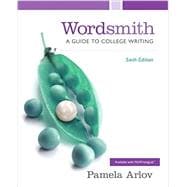0133921131 / 9780133921137 Wordsmith: A Guide to College Writing Plus MyWritingLab with Pearson eText -- Access Card Package, 6/e
This package consists of:
- 0321974174 / 9780321974174 Wordsmith: A Guide to College Writing, 6e
- 0133944131 / 9780133944136 MyWritingLab with Pearson eText -- Glue in Access Card
For courses in Writing.
Helping students to craft direct, clear, and engaging writing
Briefer and more readable than full-length texts, Wordsmith: A Guide to College Writing is the antidote to dry, overwrought, and overly expansive writing guides. Wordsmith engages students, serves multiple skill levels, and teaches enduring writing techniques in a way that is actionable, contemporary, hands-on, and fun.
This resource is a powerful tool for students and teachers alike. With appealing, topical readings and expanded writing exercises, the updated text empowers instructors to meet students where they are and engage their collective interests. Author Pam Arlov provides students with just the right balance of instruction and practice, covering grammar, rhetorical modes and mixed modes, style guidelines, and more. Her inviting writing style, use of relevant readings and visuals, and occasional humor are sure to engage any student.
Also Available with MyWritingLab™
This text is also available with MyWritingLab – an online homework, tutorial, and assessment program designed to work with this text to engage students and improve results. Within its structured environment, students practice what they learn, test their understanding, and pursue a personalized study plan that helps them better absorb course material and understand difficult concepts. In addition to the full eText activities directly from the text are available within MyWritingLab. These include the small scrawl written assignments, readings from the text, review exercises, and more.








